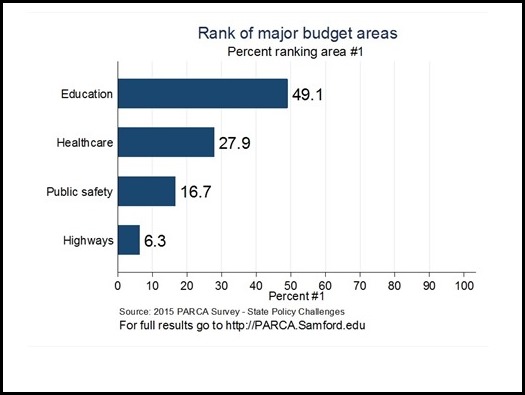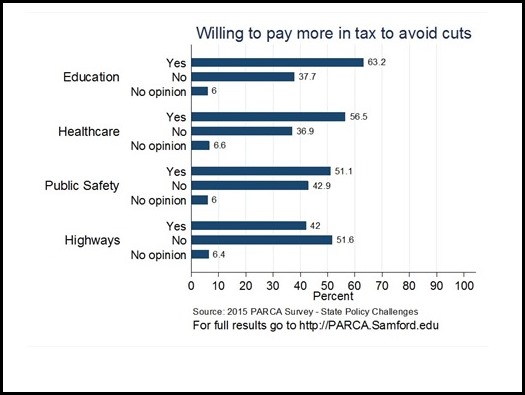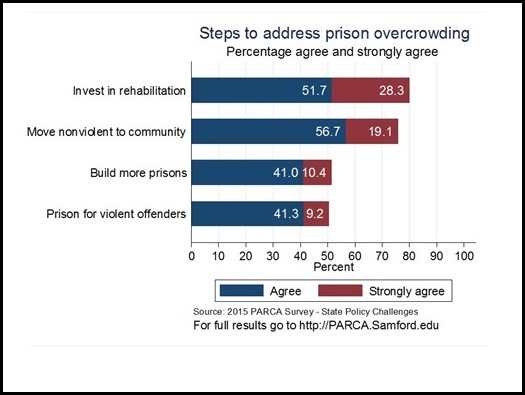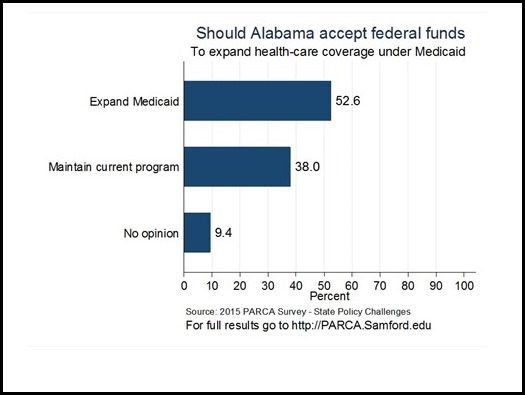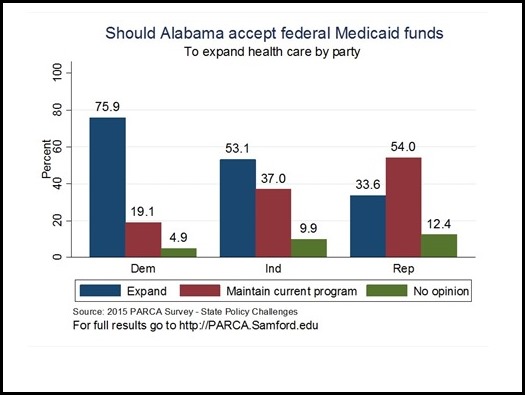
The Alabama Department of Corrections has jurisdiction over more than 32,000 individuals who’ve been convicted of a crime and are serving sentences in prisons, work release centers, supervised reentry programs, and community-based corrections programs.
That’s more than double the number of convicts the system had in its charge in 1990, but over that same period, Alabama has added little to the designed capacity of its prisons.
As a consequence, Alabama prisons hold almost twice the number of prisoners they were designed to accommodate. According to the most recent comparative figures, Alabama has the highest level of prison over-crowding in the U.S.
Alabama’s Department of Corrections depends on the state’s cash-strapped General Fund for 83 percent of its budget.
Due to the increasing costs of housing an ever greater number of prisoners, corrections spending has more than doubled since 1995, now accounting for 22 percent of General Fund appropriations, or $384 million in the 2015 budget, trailing only Medicaid as a cost to the General Fund.
| Alabama Department of Corrections |
1995 |
2015 |
| Cost to the General Fund |
$145,579,511 |
$394,281,304 |
| Percent of General Fund spending |
17% |
22% |
| Percent increase in spending since 1995 |
|
171% |
State officials are expecting a shortfall of $200 million in the General Fund for 2016, which means Alabama doesn’t have the wherewithal to begin building its way out of prison over-crowding. Corrections officials estimate they’d need a minimum of $420 million to add 6,000 new prison beds and $92 million more annually to operate the added space.
The prison problem also has acute aspects needing attention. Prison officials have declared a state of emergency in response to Department of Justice findings on conditions at Julia Tutwiler Prison for Women, including overcrowding, understaffing, and sexual abuse of prisoners by system employees. The Justice Department concluded conditions there constituted a violation of the U.S. Constitution’s prohibition against cruel and unusual punishment.
In the face of this array of problems, the Legislature earlier this year created a bipartisan Prison Reform Task Force, composed of state and local leaders drawn from all three branches of government. The creation of the Task Force was endorsed by the Governor, leaders of both Houses of the Legislature, and the Chief Justice of the Supreme Court. The Task Force is charged with finding solutions for the prison-overcrowding problem while at the same time protecting public safety.
With funding support from the U.S. Department of Justice and the Pew Charitable Trusts, the Task Force is employing the technical assistance of the Council of State Governments Justice Center (CSG Justice Center). The CSG Justice Center, a nonpartisan, nonprofit organization, has helped guide 18 states through similar exercises in corrections system reform. It began work in Alabama in the spring, presented preliminary findings in June, and updated the Task Force on September 30.
The approach advocated by the CSG Justice Center is known as Justice Reinvestment. States that have been through the Justice Reinvestment process (North Carolina and Texas among them) have been able to decrease prison populations, increase successful reentry from prison, and at the same time experience drops in crime. Strategies employed included restructuring sentencing, improving treatment and diversion options, and employing more effective practices in probation and parole supervision.
The Justice Reinvestment approach assumes that money saved by reducing the prison population can be shifted to pay for improved practices elsewhere.
| Bottom 10 States in Corrections Spending per State Prisoner,* 2011 |
| Mississippi |
$14,481 |
| Louisiana |
$14,820 |
| Alabama |
$16,477 |
| South Carolina |
$19,405 |
| Oklahoma |
$19,877 |
| Texas |
$21,043 |
| Nevada |
$21,160 |
| Tennessee |
$21,196 |
| Indiana |
$21,406 |
| Arizona |
$21,631 |
|
|
| Median State Spending per prisoner |
$36,853 |
This will be particularly difficult in Alabama. It would take a significant decline in prison population to achieve any savings in Alabama, considering the current level of overcrowding and understaffing in the prison system.
Cutting prison costs under existing circumstances seems unlikely. Alabama spends about $43 a day per inmate to clothe, feed, house, and supervise its prisoners, about $15,308 per year, per inmate in the prison system. Alabama prisons are staffed at 58 percent of authorized levels, at a ratio of 12 prisoners per correctional officer.
Reform efforts depend on an enhanced system of community supervision as an alternative to prison. However, in Alabama, the Board of Pardons and Paroles, which administers probation and parole supervision, has seen a significant erosion of its budget. The ratio of probation and parole officers to offenders is 1 to 192, far in excess of levels recommended for a successful system of supervision.
U.S. Census Bureau data indicate that Alabama spends less on corrections, probation and parole than any state other than Mississippi and Louisiana.
Other agencies involved, including the courts and the Alabama Department of Mental Health, which also depend significantly on the General Fund, have seen erosion in their financial support as well.
To save money in the long run, Alabama may very well have to find more money to spend in the short term.
The Task Force hopes to have legislative recommendations ready for the 2015 session.
How we got here
Alabama’s prison problem has been long in the making, and our state is by no means alone in its struggles.
Most states have seen their prison populations swell in recent decades. However, Alabama is among the top states in the number of people it locks up as a percentage of its population.
Alabama’s incarceration rate ranks fourth in the United States, and the U.S. leads all other countries in the rate at which it jails its citizens.
U.S. imprisonment rates have surged since the 1970s. Several factors have contributed, including legislation requiring longer sentences and the passage of habitual offender laws, which enhanced sentences for repeat offenders. Lawmakers also responded to the proliferation of drugs and drug-related crimes by enacting long sentences for those offenses.
| Incarceration Rates: Top 10 U.S. States |
Prisoners per 100,000 residents |
| Louisiana |
847 |
| Mississippi |
692 |
| Oklahoma |
659 |
| Alabama |
647 |
| Texas |
602 |
| Arizona |
586 |
| Arkansas |
578 |
| Georgia |
533 |
| Florida |
524 |
| Missouri |
521 |
Efforts to move people with mental illness out of prolonged confinement in state mental hospitals may also have also played a role. Several studies have shown that close to 20 percent of the prison population suffers from serious mental illness. And once in the criminal Justice system, the mentally ill have a harder time getting out.
Data suggest that a focus on incarceration may not be the most cost- effective approach to improving public safety. Alabama, with one of the highest incarceration rates in the country, continues to experience higher than average levels of crime. According to figures presented to the Prison Reform Task Force by the CSG Justice Center, Alabama in 2012 ranked 8th among U.S. states in total crime, 14th in violent crime, and 7th in property crime. The Public Safety Performance Project of the Pew Charitable Trusts recently pointed out that between 1994 and 2012, the top five states where incarceration rates declined the most also saw significant drops in crime.
Signs of progress
In its most recent report to the Task Force, the CSG Justice Center presented findings indicating some relief in the upward pressure on Alabama’s prison population. The total number of people under the jurisdiction of the Alabama Department of Corrections declined slightly in 2013, and so far in 2014 that trend seems to be continuing.
| Facts on Criminal Justice Supervision in Alabama |
|
| ADOC Jurisdictional Population, June 2014 |
32,235 |
| ADOC In-House Population |
25,020 |
| ADOC In-House Designed capacity |
13,318 |
| Occupancy rate |
188% |
| Individuals on Probation |
54,288 |
| Individuals on Parole |
9,873 |
| Individuals on Probation and Parole |
364 |
| Total on Probation and Parole |
64,525 |
| Total individuals under the supervision of Dept. of Corrections and Board of Pardons and Paroles |
96,760 |
| Ratio of Inmates to Correctional Officers |
12 to 1 |
| Ratio of Individuals on Probation/Parole to Supervising Officers |
192 to 1 |
| Spending per prisoner per year |
$15,308 |
|
|
| Cost Per Day |
|
| Prison |
$43 |
| Supervised Release Program |
$17 |
| Community corrections |
$10 |
| Cost per day probation/parole |
$1.70 |
Declining crime rates resulted in 10,000 fewer arrests in 2013 compared to 2009. Felony convictions have declined during the same period, including a 34 percent drop in felony sentences for robbery and a 33 percent drop in convictions for felony possession of a controlled substance. The number of prison sentences for drug and property crimes declined by 24 percent from 2011 to 2014, with the sharper decline coming after October 2013.
That’s when new presumptive sentencing guidelines went into effect. The guidelines establish uniform parameters in sentencing for non-violent offenders and promote community supervision for non-violent offenders in appropriate cases. The CSG Justice Center data indicate that under the guidelines there has been an acceleration in the number of offenders diverted from prison and toward probation and community corrections.
These latest changes to sentencing are only the most recent. Alabama has been working for more than a decade to relieve pressure on prisons. Drug courts have been established in 66 of Alabama’s 67 counties and mental health courts operate in some jurisdictions.
Despite these measures to decrease in in-flow, the prison population has remained stubbornly high. The number of people being released from prison has dropped. CSG is in the process of determining why the rate of approvals for parole rates is declining when there appears to be a backlog of inmates eligible for parole.
Breaking the cycle
Alabama’s approach to probation and parole and other forms of community supervision may end up being a central focus of the Prison Reform Task Force.
A robust system for improving the success rate of those on probation or parole can result in long-term savings by decreasing returns to prison, while at the same time increasing public safety. In Alabama in 2013, 40 percent of all admissions to ADOC custody had violated the terms of probation or parole.
A growing body of research suggests that recidivism rates can be reduced by careful assessment of individuals admitted to probation and parole, to determine their likelihood of reoffending. Using such assessments, intense supervision and treatment can be given to those at the greatest risk of re-offending. Research also suggests that a Parole and Probation program must have a swift, consistent, and cost-effective system for dealing with violations to parole, using a graduated range of sanctions and incentives. According to CSG Justice Center research, no such system exists in Alabama.
At its current level of support, the Board of Pardons and Paroles employs one parole officer for every 192 individuals under supervision. The American Probation and Parole Association has developed recommended staffing levels, which vary according to the type of offender being supervised: a ratio of one officer working with 20 individuals deemed to be at a high risk of reoffending; one officer for 50 medium risk individuals; and one officer for every 200 low risk individuals.
Probation and parole are very cost-effective when employed correctly. In Alabama, 64,525 individuals are under the supervision or the Board of Pardons and Paroles. That amounts to about $1.70 per day, per supervised individual. Even if the Board were staffed at twice the level of today, which would more nearly approximate the recommended staffing ratio, the cost would be $3.40 per day, less than a tenth of the cost per day in Alabama’s prisons.
However, even as the system is putting more emphasis on community supervision, General Fund support for the Board of Pardons and Paroles has declined significantly in recent years. That decline in General Fund support has been only partially offset by an increase in the fees required of those under supervision, from $30 a month to $40.


